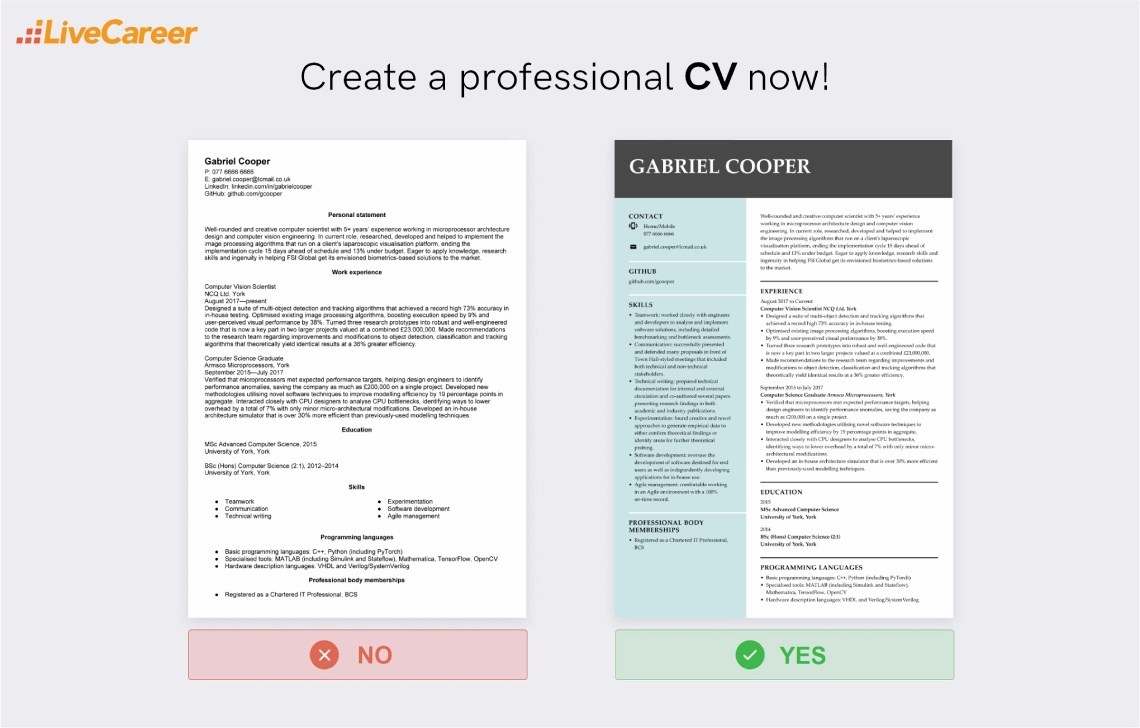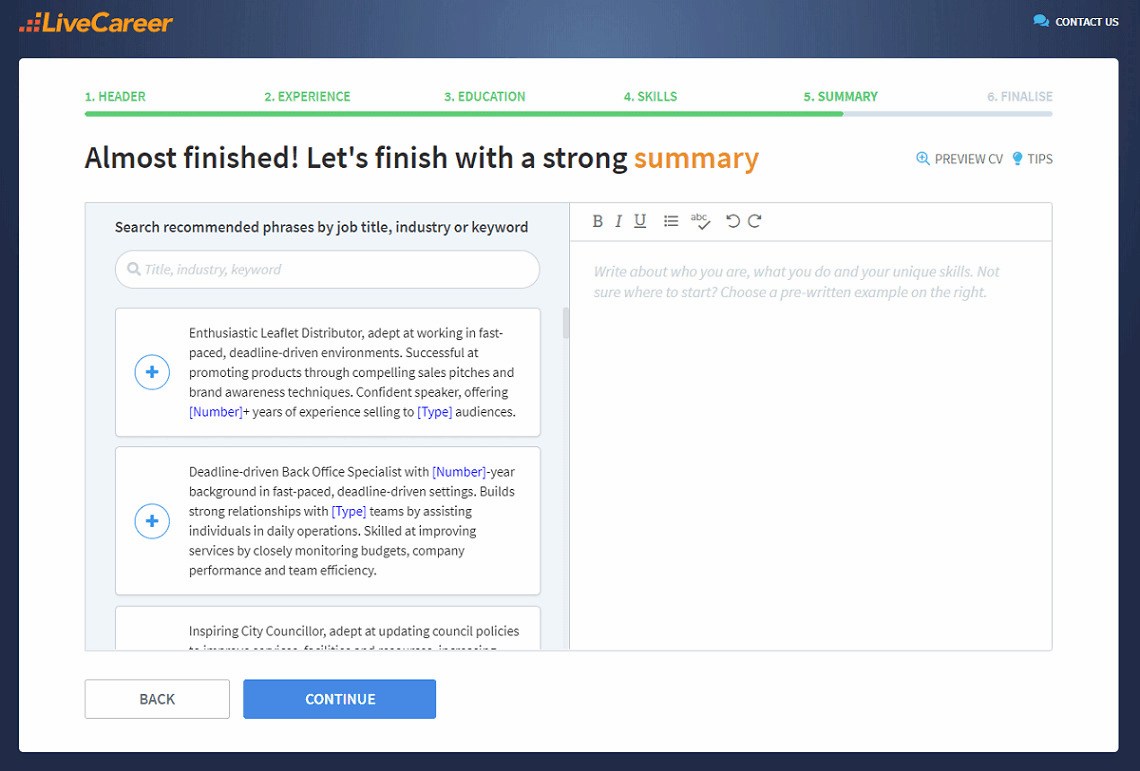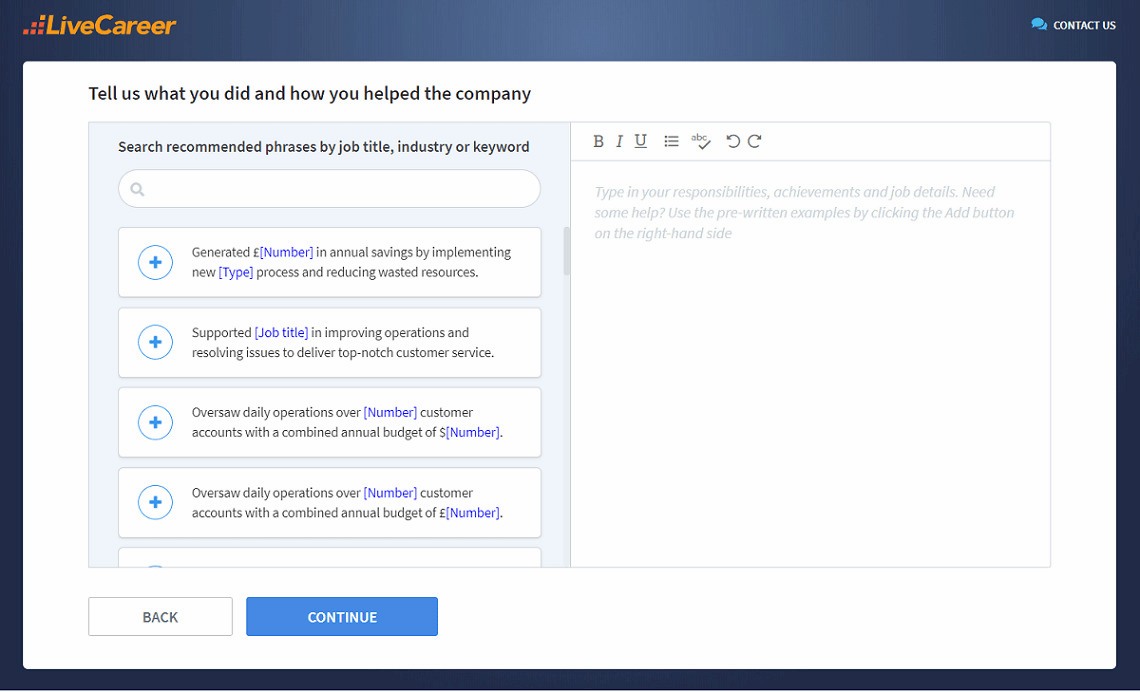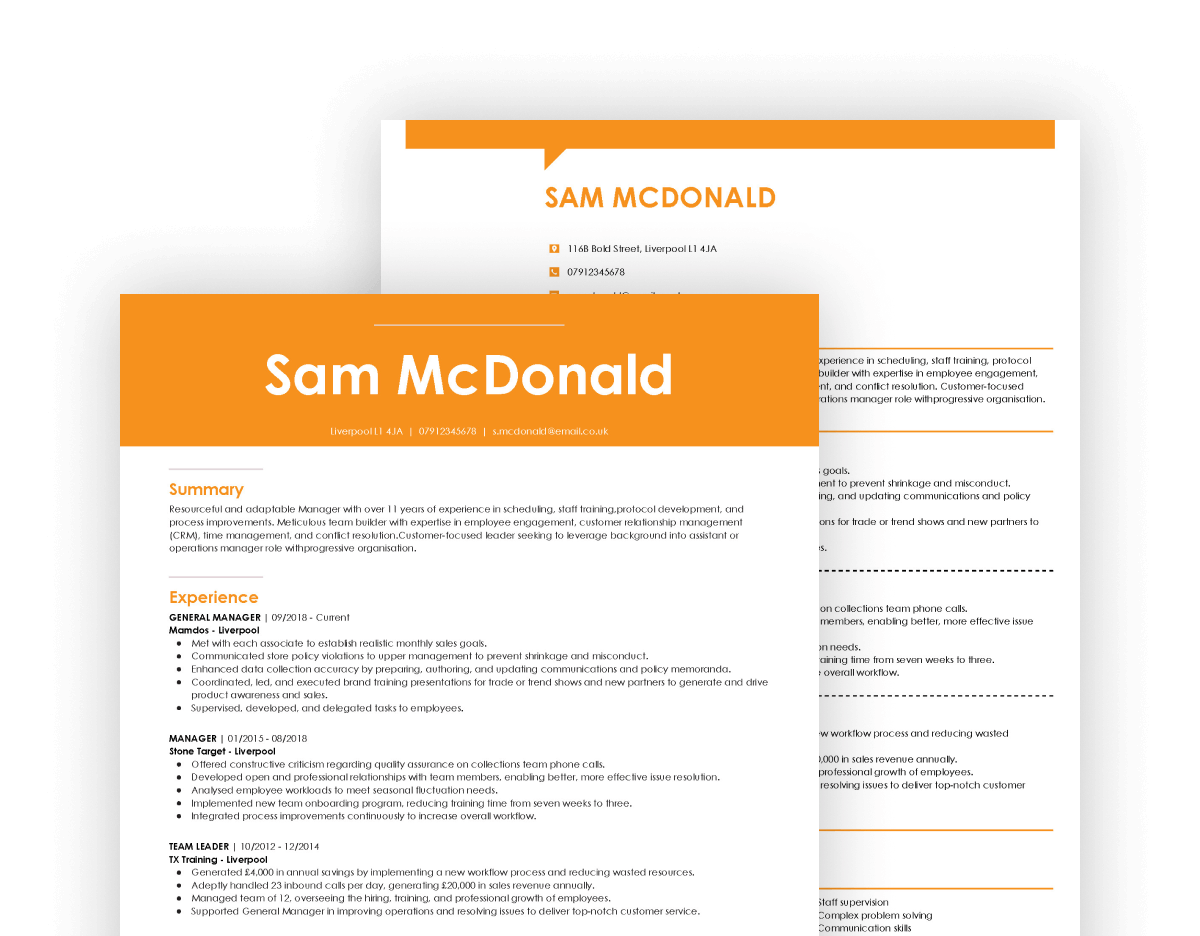Creative CV Templates to Use in 2025 [PDF & Word]
See the best 15 editable creative CV templates carefully chosen by career experts. Use our creative cv template and download your CV in Word or PDF format.
Our customers were hired by:
An education in computer science opens the door to a bewildering number of career paths. From database administration through cybersecurity analysis to the most esoteric and bleeding-edge fields of research that require a PhD at entry level. As a computer scientist you’re virtually guaranteed a job.
In this guide, you'll learn how to write a computer science CV to prove your technical proficiency, including a convincing computer science personal statement that beats competitors. And if you're a graduate, you might also be interested in discovering expert tips and examples to make your computer science CV more compelling.
Create an effective CV in minutes. Choose a professional CV template and fill in every section of your CV in a flash using ready-made content and expert tips.

We created the sample on the right using our builder. See other good CV examples like this one.
Need a different CV example? Check these samples:
Haven't found what you're looking for? Check all our CV samples.
Based on over 6 million CVs created in our builder, we found out that*:
*The data comes from a period of the last 12 months (August 2023-August 2024).
Gabriel Cooper
P: 077 6666 6666
E: gabriel.cooper@lcmail.co.uk
LinkedIn: linkedin.com/in/gabrielcooper
GitHub: github.com/gcooper
Personal statement
Well-rounded and creative computer scientist with 5+ years’ experience working in microprocessor architecture design and computer vision engineering. In current role, researched, developed and helped to implement the image processing algorithms that run on a client’s laparoscopic visualisation platform, ending the implementation cycle 15 days ahead of schedule and 13% under budget. Eager to apply knowledge, research skills and ingenuity in helping FSI Global get its envisioned biometrics-based solutions to the market.
Work experience
Computer Vision Scientist
NCQ Ltd, York
August 2017—present
Computer Science Graduate
Armsco Microprocessors, York
September 2015—July 2017
Education
MSc Advanced Computer Science, 2015
University of York, York
BSc (Hons) Computer Science (2:1), 2012–2014
University of York, York
Skills
Programming languages
Professional body memberships
Now you know what a model CV looks like. Let's write your own now.
Your computer science personal statement (also called a CV profile) is your opportunity to introduce yourself to recruiters, it’s a snapshot of you as a computer scientist and a professional. This is that make-or-break moment, the proverbial elevator ride during which you can make your pitch and argue your case.
The best computer science personal statements do three things. They introduce you and summarise your experience, they show what you have to offer in a fully objective and quantified way, and they show how your professional goals fall perfectly into line with the employers’.
A good personal statement (or a CV summary) for a computer science job will be 3–4 sentences long and contain 50–150 words. You’ll also need to write a new one for each application you send out. This is one of the most important ways in which you can tailor your application to each position—something’s that’s absolutely crucial.
This can all seem a little discouraging, but the good news is that you can easily and painlessly achieve all of the above in your computer science personal statement. Simply use a total of 3–4 sentences to answer these questions:
That’s all there is to it. Answer these questions, make sure everything flows together nicely and you have your algorithmically-generated computer science personal statement done. Coming up with relevant, measurable achievements is by far the most difficult part, but there’s a procedure for doing that as well.
An ‘achievement’ is a brief description of actions you took (usually to solve a problem) and the benefits that ensued for your employer as a result. Use accomplishment statements to help structure your achievements. Start each statement with a verb like created, oversaw, implemented, and so on.
Your application is likely to be processed by an Applicant Tracking System (ATS), so be sure to mention the company by name and the job title for which you’re applying somewhere in your computer science personal statement. Pay attention to keywords used in the advert and try to mirror them in your statement.
Your job descriptions will be populated entirely with quantified achievements, so the work you do now will help you write your work experience section and vice versa. For this reason, you may find it helpful to come back to your personal statement once you’ve finished your job descriptions.
Well-rounded and creative computer scientist with 5+ years’ experience working in microprocessor architecture design and computer vision engineering. In current role, researched, developed and helped to implement the image processing algorithms that run on a client’s laparoscopic visualisation platform, ending the implementation cycle 15 days ahead of schedule and 13% under budget. Eager to apply knowledge, research skills and ingenuity in helping FSI Global get its envisioned biometrics-based solutions to the market.
A strong CV summary will convince the recruiter you’re the perfect candidate. Save time and choose a ready-made personal statement written by career experts and adjust it to your needs in the LiveCareer CV builder.

Dealing with computation in so many of its forms, you no doubt have a good sense of the importance of conventions and the effects of user expectations on efficient interfacing. The same holds true for your computer science CV template: it’s best to use any conventions to your advantage.
Use a chronological format for your CV, starting from your most recent work experience and working your way back from there. This is what hiring managers are used to dealing with and it’s also what ATSs can parse most easily—although you’re probably in a position to know best when it comes to ATS algorithms.
This is not a good CV format for a lecturer in computer science, though. An academic CV format is the better choice for a computer science lecturer CV. Similar to a chronological format in many ways, it’ll include much more information on your academic publications, conferences and teaching experience.
Use this template to create a subheading for each job description:
[Job Title]
[Company Name, Location]
[Dates of Employment]
Populate each job description with up to six bullet points. Each and every bullet point should be a quantified accomplishment statement. Don’t pad your job descriptions with responsibilities, stick to that which is concrete and measurable.
If you’re writing a computer science student CV or computer science graduate CV and don’t have much in the way of experience yet, then focus on any projects you’ve completed independently or on a volunteer basis as well as any internships and placement work you’ve done. Highlighting these experiences can make your first CV stand out.
Computer Vision Scientist
NCQ Ltd, York
August 2017—present
Computer Science Graduate
Armsco Microprocessors, York
September 2015—July 2017
It’s virtually impossible to become a computer scientist without having an appropriate degree with many roles even requiring a PhD. So make sure your education section includes a clear and concise rundown of your academic background. Use the following template to set out your university degrees:
[Degree Type] [Degree Name](Degree Class), [Years Attended]
[Institution Name], [Institution Location]
If you’re currently studying a particular degree, then include an expected graduation date. If you’re writing a computer science undergraduate CV, then use the following templates to detail your high school education:
A-levels: [Subject Name 1], [Subject Name 2], [Subject Name 3]
[School Name], [School Location], [Years Attended]
[n] GCSEs (including Mathematics and English)
[School Name], [School Location], [Years Attended]
where n is the number of GCSEs you completed.
Just graduated from university and don’t have much experience yet? Put this section above your work experience section and add bullet points highlighting your academic achievements and areas of excellence.
MSc Advanced Computer Science, 2015
University of York, York
BSc (Hons) Computer Science (2:1), 2012–2014
University of York, York
“Early in a career, education is significant, but hands-on experience becomes more valuable over time. In the USA, education still holds weight, especially for higher-level positions, but practical skills and real-world experience increasingly outweigh formal education, particularly in fast-paced industries like technology”.
Your achievements will speak to your general computer science skills but it’s important to include a more explicit list of skills for recruiters (and ATSs) to compare with their requirements. Research has also shown the importance of paying attention to soft as well as technical skills in IT and related fields.
Start by making a master list of your computer science skills in a separate document. List as many of your computer science skills as you can. Once you start running out of ideas, go back and add a sentence onto each skill that shows how and when you demonstrated that skill at work. That's how a good computer science CV should look like.
Any skill for which you can’t add such a sentence doesn’t make the cut. Save your list of demonstrated computer science skills—it’ll come in handy for future job applications. Copy 5–10 skills from your master list into your computer science CV, being sure to at least cover those mentioned in the advert.
Pay attention to the keywords used in the advert and substitute synonyms as necessary to better mirror them in your skills section. This will help ATSs more accurately filter your CV and it’ll also help recruiters see more easily that you’re the one they’re looking for.
It’s a truism at this point to say that a computer science degree can lead to a huge variety of career paths. As a result, the term ‘computer scientist’ means many things to many people. Paint a clearer and fuller portrait of yourself as a computer scientist by adding extra sections to your CV.
You could include sections for awards you’ve won, volunteer work you do, languages you speak, even your hobbies and interests. As long as it’s relevant to the job at hand, it’s fair game. A section on programming languages is particularly beneficial in a computer science CV, rather than mixing these in with your other skills.
Programming languages
Professional body memberships
Just as you wouldn’t hand someone a pile of research or raw data without introducing and summarising it, you shouldn’t just send your CV in without a cover letter. It’s true that some employers don’t care about cover letters but you don’t want to send a bad one to one of the many employers who do.
Complement your computer science CV with a cover letter that follows the standard UK business letter format, including:
Make a strong case for why you’re the best computer scientist for the job by structuring the body of your cover letter like this:
Your finished cover letter will be between half an A4 page and a full A4 page, about 250–400 words in total. You can skip writing a cover letter if and only if you’ve been explicitly asked not to include one—you’d be doing your application a huge disservice otherwise.
Before you send your computer science CV to the recruiter, check its contents once again and follow these rules:
Nothing could be more basic or important. Code only works if it’s correct down to the punctuation mark, make sure your computer science CV and cover letter demonstrate that same attention to detail. Get a second pair of eyes on your work and use an app, web app or built-in spelling and grammar check.
No one enjoys reading monolithic chunks of code, no matter how functional or even well-commented out. Let your CV and cover letter breathe and keep recruiters on your side.
When it comes to the perfect CV length, aim for a single A4 page, two at most (and only if you have 20 or more years’ experience).
Check in with the recruiter if you haven’t heard back after a week. This certainly can’t hurt and might even make a significant difference. At the very least, you’ll get an update on the progress of your application.
You don’t have to be a CV writing expert. In the LiveCareer CV builder you’ll find ready-made content for every industry and position, which you can then add with a single click.

I hope this article has been helpful in getting your computer science job application together, from the all-important personal statement through to an expertly-targeted cover letter. Is there anything you’d like more information on? Please leave your questions, comments, feedback and experiences below.
Our editorial team has reviewed this article for compliance with Livecareer’s editorial guidelines. It’s to ensure that our expert advice and recommendations are consistent across all our career guides and align with current CV and cover letter writing standards and trends. We’re trusted by over 10 million job seekers, supporting them on their way to finding their dream job. Each article is preceded by research and scrutiny to ensure our content responds to current market trends and demand.
About the author
Since 2013, the LiveCareer UK team has shared the best advice to help you advance your career. Experts from our UK editorial team have written more than one hundred guides on how to write the perfect CV or cover letter.
Rate this article:
Computer science cv
Average:

See the best 15 editable creative CV templates carefully chosen by career experts. Use our creative cv template and download your CV in Word or PDF format.
See when to use a skills based CV and how to write it for the UK job market. Learn from the free skills based CV examples and download a functional CV template.
In many cases, the date of birth on a CV is not demanded and even not necessary. However, there are situations where it comes in handy. Want to learn more about it? Read on.
Our customers were hired by: